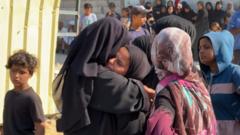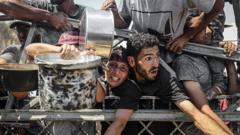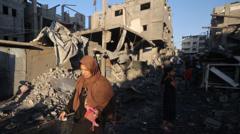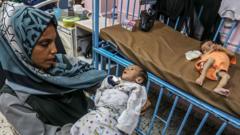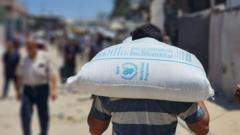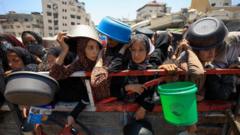An analysis of the food aid boxes distributed in Gaza reveals significant nutritional shortcomings that could lead to long-term health issues for recipients.
**Gaza's GHF Food Aid Boxes: A Closer Look at Their Contents and Nutritional Value**
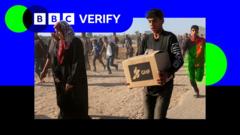
**Gaza's GHF Food Aid Boxes: A Closer Look at Their Contents and Nutritional Value**
The Gaza Humanitarian Foundation provides aid amidst a growing malnutrition crisis in the region.
The ongoing humanitarian crisis in Gaza has left over two million people facing severe hunger, as revealed by the latest reports from the United Nations. The Gaza Humanitarian Foundation (GHF), supported by the US and Israel, has distributed 91 million meals since May, mainly through food boxes. Although access for international journalists is restricted, insights into the GHF aid boxes have emerged through photos and expert evaluations.
In recent social media posts, Palestinians showcased the contents of these food boxes, which include predominantly dried items like pasta, chickpeas, lentils, and wheat flour along with essential cooking staples such as oil and salt. The GHF also offers some ready-to-eat options including halva bars, but the overall composition leans heavily toward items requiring cooking.
Each box purportedly contains about 42,500 calories, claimed to sustain 5.5 individuals for 3.5 days, although independent analysis points to critical omissions in nutritional adequacy. Experts like Prof. Stuart Gordon from the London School of Economics characterize the aid as a “first aid” food basket, useful for immediate short-term relief yet lacking in essential vitamins and minerals necessary for a balanced diet. Prof. Gordon warns that long-term reliance on such a diet can provoke “hidden hunger,” leading to serious health issues such as anemia and scurvy.
Further, Dr. Andrew Seal from University College London emphasizes the boxes are deficient in vital nutrients like calcium and iron, while also indicating inadequate options for young children. Unlike the GHF, major organizations such as the World Food Programme (WFP) provide more holistic nutrition, addressing specific needs for vulnerable populations.
Currently, those lucky enough to secure a food box face additional challenges; the need for clean water and fuel to prepare the dried food is critical. With the ongoing water crisis in Gaza worsening, families have been compelled to resort to unsafe cooking methods, raising further health concerns. The situation is dire, with the UN reporting an urgent need for intervention as malnutrition rates soar, particularly among women and children.
Despite the documented challenges, the GHF has not publicly responded to inquiries about potential adjustments or improvements to their food aid strategy. The complexity of the Gaza humanitarian crisis continues to unfold, drawing concern from global humanitarian agencies as they track the rising malnutrition rates and the pressing need for effective aid delivery.
In recent social media posts, Palestinians showcased the contents of these food boxes, which include predominantly dried items like pasta, chickpeas, lentils, and wheat flour along with essential cooking staples such as oil and salt. The GHF also offers some ready-to-eat options including halva bars, but the overall composition leans heavily toward items requiring cooking.
Each box purportedly contains about 42,500 calories, claimed to sustain 5.5 individuals for 3.5 days, although independent analysis points to critical omissions in nutritional adequacy. Experts like Prof. Stuart Gordon from the London School of Economics characterize the aid as a “first aid” food basket, useful for immediate short-term relief yet lacking in essential vitamins and minerals necessary for a balanced diet. Prof. Gordon warns that long-term reliance on such a diet can provoke “hidden hunger,” leading to serious health issues such as anemia and scurvy.
Further, Dr. Andrew Seal from University College London emphasizes the boxes are deficient in vital nutrients like calcium and iron, while also indicating inadequate options for young children. Unlike the GHF, major organizations such as the World Food Programme (WFP) provide more holistic nutrition, addressing specific needs for vulnerable populations.
Currently, those lucky enough to secure a food box face additional challenges; the need for clean water and fuel to prepare the dried food is critical. With the ongoing water crisis in Gaza worsening, families have been compelled to resort to unsafe cooking methods, raising further health concerns. The situation is dire, with the UN reporting an urgent need for intervention as malnutrition rates soar, particularly among women and children.
Despite the documented challenges, the GHF has not publicly responded to inquiries about potential adjustments or improvements to their food aid strategy. The complexity of the Gaza humanitarian crisis continues to unfold, drawing concern from global humanitarian agencies as they track the rising malnutrition rates and the pressing need for effective aid delivery.

